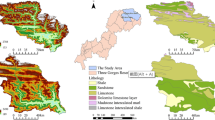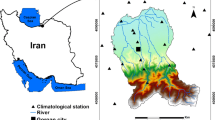Abstract
Land use changes extensively affect soil erosion, which is a great environmental concern. To evaluate the effect of land use change on soil erosion in fast economic developing areas, we studied land use changes of Guangdong, China, from 2002 to 2009 using remote sensing and estimated soil erosion using the Universal Soil Loss Equation. We calculated the areas and percentage of each land use type under different erosion intensity and analyzed soil erosion changes caused by transitions of land use types. In addition, the impact of land use change on soil erosion in different river catchments was studied. Our results show that forest and wasteland land conversions induce substantial soil erosion, while transition from wasteland to forest retards soil loss. This suggests that vegetation cover changes significantly influence soil erosion. Any conversion to wasteland causes soil erosion, whereas expansion of forests and orchards mitigates it. The most significant increase in soil erosion from 2002 to 2009 was found in the Beijiang catchment corresponding to the transition from forest/orchard to built-up and wasteland. Soil erosion in the Xijiang catchment accelerated in this period due to the enormous reduction in orchard land. In Hanjiang catchment, erosion was alleviated and vegetation coverage greatly expanded owing to considerable transitions from wasteland and cropland to orchards. Field investigations validated our estimations and proved the applicability of this method. Measures including protecting vegetation, strict control of mining as well as reasonable urban planning should be taken to prevent successive soil erosion.






Similar content being viewed by others
References
Bini C, Gemignani S, Zilocchi L (2006) Effects of different land use on soil erosion in the pre-alpine fringe (North-East Italy): ion budget and sediment yield. Sci Total Environ 369(1–3):433–446
Chen SL (2000) Study on the relationship between soil erosion and land use based on GIS. J Fujian Teach Univ (Nat Sci) 16(1):106–109
Chen CY, Huang WL (2012) Land-use management and landslide characteristics analysis using GIS for community-based disaster mitigation. Environ Monitor Assess (on-line). doi:10.1007/s10661-012-2855-y
Chen YH, Pan WB, Cai YB (2007) Quantitative study of soil erosion in watershed based on RS, GIS and RUSLE-A case study of the Jixi watershed in Fujian Province. J Geol Haz Environ Preserv 18(3):5–10
Erda W, Chang X, Jimmy RW, Cheng X (2006) Predicting soil erosion for alternative land uses. J Environ Qual 35(2):459–467
Fu BJ, Chen LD, Ma KM (1999) The effect of land use change on regional environment in the Yangjuangou catchment in the Loess Plateau of China. Acta Geographica Sinica 54(3):241–246
Fullen MA, Booth CA, Brandsma RT (2005) Long-term effects of grass ley set-aside on erosion rates and soil organic matter on sandy soils in east Shropshire, UK. Soil Tillage Res 89:122–128
Guangdong Soil census office (1993) Guangdong soil. Science Press
Hansen AJ, De Fries R, Turner W (2004) Land use change and diversity: a synthesis of rates and consequences during the period of satellite imagery. In: Gutman G, Justice C (eds) Land change science: observing, monitoring, and understanding trajectories of change on the earth’s surface. Springer, New York, pp 277–299
Helena M, Lubos M, William MB (2001) Multiscale simulation of land use impact on soil erosion and deposition pattern. In: The 10th international soil conservation organization meeting, Purdue University, pp 1163–1169
Huang JL, Hong HS, Zhang LP, Du PF (2004) Study on predicting soil erosion in Jiulong River watershed based on GIS and USLE. J Soil Water Conserv 18(5):75–79
IGBP-IHDP (1995) Land-use and land-cover change science/research plan. IGBP report no. 35 and IHDP report no. 7, IGBP, Stockholm and IHDP, Geneva
Ito A (2007) Simulated impacts of climate and land-cover change on soil erosion and implication for the carbon cycle, 1901 to 2100. Geophys Res Lett 34:L09403. doi:10.1029/2007GL029342
Jordan G, van Rompaey A, Szilassi P, Csillag G, Mannaerts C, Woldai T (2005) Historical land use changes and their impact on sediment fluxes in the Balaton basin (Hungary). Agric Ecosyst Environ 108:119–133
Li HX, Liu SZ, He XR, Fan JR (2004) Analysis of the relationship between soil erosion intensity and land use change in Suining city. Soil Water Conserv China 3:37–49
Liang Y, Shi XZ (1999) Soil erodiable K in east hilly fields of the southern Yangtze River. Res Soil Water Conserv 6(2):47–52
Liu P (2008) Analysis of the spatial variability of soil erosion amount in Guangdong Province based on GIS. South China Agricultural University, China
Liu BY, Nearing MA, Risse LM (1994) Slope gradient effects on soil loss for steep slopes. Trans ASAE 37:1835–1840
Lv XX, Shen RM (1992) A preliminary study on the values K of soil erosibility factor. J Soil Water Conserv 6(1):63–70
Ma CF, Ma JW, Buhe A (2001) Quantitative assessment of vegetation coverage factor in USLE model using remote sensing data. Bull Soil Water Conserv 21(4):6–9
Ma HL, Wang ZL, Zhou XW (2010) Estimation of soil loss based on RUSLE in Zengcheng, Guangdong Province. Yangtze River 41:90–93
Martha MB, Gerard G, van Anne D, Fabien Q, Dimitris C, Mark R (2008) The response of soil erosion and sediment export to land-use change in four areas of Europe: the importance of landscape pattern. Geomorphology 98(3–4):213–226
McCool DK, Foster GR, Mutchler CK, Meyer LD (1987) Revised slope steepness factor for the universal soil loss equation. Trans ASAE 30:1387–1396
Meng QH, Fu BJ, Yang LZ (2001) Effects of land use on soil erosion and nutrient loss in the three gorges reservoir area, China. Soil Use Manag 17:288–291
Pan MH, Wu YQ, Ren FP, Dong YF, Jiang Y (2010) Estimating of soil erosion in the Dongjiang River Basin based on USLE. J Nat Resour 25(12):2154–2164
Rey F (2003) Influence of vegetation distribution on sediment yield in forested marly gullies. Catena 50(2–4):549–562
Robert H (2000) Slope angle and slope length solutions for GIS. Cartography 29(1):1–8
Sharma A, Tiwari KN, Bhadoria PBS (2011) Effect of land use land cover change on soil erosion potential in an agricultural watershed. Environ Monitor Assess 173(1–4):789–801
Shi DM (1991) Soil erosion and its control in the granite region of Southern China. J Soil Water Conserv 5(3):61–72
Solaimani K, Modallaldoust S, Lotfi S (2009) Investigation of land use changes on soil erosion process using geographical information system. Int J Environ Sci Tech 6(3):415–424
Souchere V, King CH, Dubreuil N, Lecomte-Morel V, Le Bissonnais Y, Chalat M (2003) Grassland and crop trends: role of the European Union Common Agricultural Policy and consequence for runoff and soil erosion. Environ Sci Policy 6:7–16
Statistics Bureau of Guangdong Province, National Bureau of Statistics Guangdong Survey Organization (2003 and 2010) Guangdong Statistical Yearbook. China Statistics Press
Stoate C, Boatman ND, Borralho RJ, Carvalho CR, De Snoo GR, Eden P (2001) Ecological impacts of arable intensification in Europe. J Environ Manag 63:337–365
Szilassi P, Jordan G, Van Rompaey A, Csillag G (2006) Impacts of historical land use changes on erosion and agricultural soil properties in the Kali Basin at Lake Balaton, Hungary. Catena 68(2–3):96–108
Tang GA, Yang X (2006) Experimental tutorial for GIS spatial analysis using ARCGIS. Science Press
Wang SY, Liu JY, Zhang ZX, Zhang ZK (2001) Study on spatial-temporal feature of land use and land cover under different background of soil erosion. J Soil Water Conserv 15(3):48–51
Wischmeier WH, Johnson CB, Cross BV (1971) A soil erodibility nomograph farmland and construction sites. J Soil Water Conserv 26(5):189–193
Yu QG (1996) Land use and soil erosion study by use of remote sensing information in Hongtagou watershed on Rolling Loess Plateau. J Soil Water Conserv 2(2):24–31
Zhang LM (2005) Soil erodibility and its relative factors of different soil types in subtropical China. South China University of Tropical Agriculture, China
Zhou FJ, Chen MH, Lin FX, Huang YH, Lu CL (1995) The rainfall erosivity index in Fujian Province. J Soil Water Conserv 9(1):13–18
Zhu LA, Wang JZ, Zhuo MN, Zhang HH (2003) Regional disparity of soil and water loss in Guangdong Province. Bull Soil Water Conserv 23(6):36–38
Zou YR, Zhang ZX, Zhou QB, Liu B, Wang BC (2002) Analysis of the relationship between soil erosion and land use based on GIS. Res Soil Water Conserv 9(1):67–69
Acknowledgments
National Key Technologies R&D Program in the 12th Five-year Plan of China (2012BAH32B03), NSFC (41171288) and Guangdong NSF (8151064004000013) are acknowledged for financial supports. Thanks to the National Aeronautics and Space Administration (NASA) for MODIS L1B data, and the China Meteorological Data Sharing Service System for sharing the meteorological products. Prof. Bernard de Jong of Utrecht University is greatly acknowledged for his help to improve the English of this manuscript. This is contribution No. IS-1687 from GIGCAS.
Author information
Authors and Affiliations
Corresponding author
Rights and permissions
About this article
Cite this article
Li, L., Wang, Y. & Liu, C. Effects of land use changes on soil erosion in a fast developing area. Int. J. Environ. Sci. Technol. 11, 1549–1562 (2014). https://doi.org/10.1007/s13762-013-0341-x
Received:
Revised:
Accepted:
Published:
Issue Date:
DOI: https://doi.org/10.1007/s13762-013-0341-x




